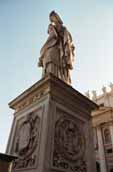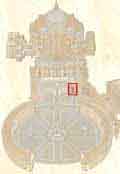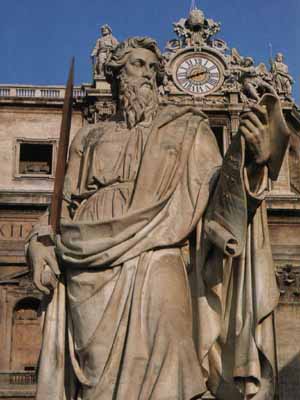| Grottoes
Vatican City Colonnade Saints Floorplan #2 |
| Altars
Monuments The History |
|
Related Items |
 |
From: Roma Sacra - San
Pietro in Vaticano, © 1995 Elio de Rosa
The replaced, older statues of Sts. Peter and Paul were the work of Paolo
di Mariano, called the Taccone, and his workshop (1461-1462), and are
currently in a room of the Library of Sixtus IV, in the Apostolic Palaces.
In 1849, the stonecutters, Angelo Bezzi, Fortunato Martinori and Vincenzo
Biancheri, completed the tall pedestals, decorating them with the heraldic
emblems of Pius IX and of the Reverend Fabbric of St. Peter, indicated
with the letters R.F.S.P. In the internal mirror of the base, there is
the inscription:
PIUS IX PONT. MAX. / PAVLI DOCTORIS GENTIVM/ SIGNVM / MAGNITVDINI TEMPLI
VAT. PAR / HEIC OPPORTVNO IN LOCO / STARE IVSSIT / ANNO MDCCCXLVII / SCARI
PRINCIPATVS EIVS I / LAVRENTIO LVCIDI CVR. OP. VAT.
(The Pontiff ordered the images themselves here, in a suitable place, equal to the size of the temple of Peter prince of the Apostles. In the year 1847, the first of his pontificate, while he was curator of the Vatican Works Lorenzo Lucidi)
From: Works on the Facade
of St. Peter's Basilica, Vatican Polyglot Press, 1989
The Old Statues
During the Pontificate of Pius II (Enea Silvio Piccolomini, 1458-1464)
the statues of Saints Peter and Paul were placed at the lower part of
the marble staircase at the entrance to the Constantinian Basilica.
Some authors, among them Bonanni, Torrigio and Mignanti, attribute the two statues to Mino da Fiesole; Vasari, however, believes that they were the work of Mino of Reame, while Muntz claims that they are by Paolo Romano. With the continuation of the Vatican Basilica, begun in 1502 and completed in 1612 with the construction of the imposing facade by Maderno (1556-1629), the statues were maintained in an analogous position, but brought further to the front of the new structure.
During the pontificate of Alexander VII (Fabio Chigi 1655-1629), the architect Gianlorenzo Bernini finished the work on St. Peter's Square, with his great sloping entrance to the threshold of the Vatican Basilica; in 1666 he had completed the famous colonnade after nine years of intense labor. Bernini himself adapted the two statues of Peter and Paul at the foot of the stairs, even though their dimensions were much smaller than the new architectural complex of the Basilica demanded.
The Current Statues
In 1849 Pope Pius IX (Giovanni Mastai Ferretti, 1846-1878) decided to
replace the above-mentioned statues with the larger ones that his predecessor,
Gregory XVI (Bartolomeo Alberto Cappellari, 1831-1846), had commissioned
for the Basilica of St. Paul's Outside-the-Walls. These statues had never
been placed there because they were judged to be unsuitable for the inside
of that Basilica.
It is known that the plaster model used for the execution of the marble statue by Carrara as well as the plaster of the statue of St Paul, were given by Pope Pius IX to the church of St Carlo ai Catinari, where it was placed in a niche in the apse, on the left when facing the high Altar.
The figure of the apostle has a noble bearing, with the 2.79 meter long sword (which has lost its original gold-plating) in his right hand; his left holds a book. The pointed beard finishes off the especially expressive face; the drapery, with classical folds, is unrestrained and balanced. On the book is the inscription, in Hebrew letters of the fourteenth-fifteenth century style, reading: "I can do all things in him who strengthens me", recalling the text from Paul's Letter to the Philippians, chapter 4, verse 13.
In the statue of St Paul, Tadolini, faithful heir and interpreter of the principles of Canovian art, seems to echo the sculptural renewal which, beginning in Tuscany, also caused the Roman artistic world to strive for a more faithful representation of reality.
The author of numerous works, funerary and honorary as well, Tadolini is responsible for the statue of St Frances de Sales (founder of the Visitation Order), which is located in the tribune of the Chair in St Peter's, as well as for the design of the Monument of Pius VI, Braschi (1775-1799); the large statue of the Pontiff is located in the central nave of the Vatican Grottoes, the "Pieta" is in the cathedral of Terracina, and the two symbolic statues of Humility and Charity, originally a part of this Monument, are in the Pontifical Lateran Seminary.


